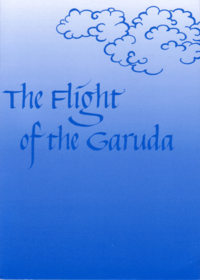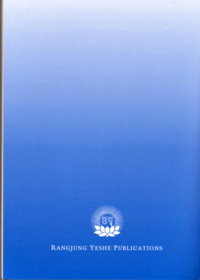The Flight of the Garuda, by Erik Pema Kunsang
 |
 |
Title
The Flight of the Garuda
Five Texts from the Practice Lineage
Foreword by Chökyi Nyima Rinpoche
Translated by Erik Pema Kunsang
Rangjung Yeshe Publications
Please notice:
“It is the opinion of myself and Dudjom Rinpoche that texts such as these should only be shared with people who have received the pointing-out transmission from a qualified master.”
H.H. Dilgo Khyentse Rinpoche.
Address letters to:
Rangjung Yeshe Publications
Ka-Nying Shedrub Ling Monastery
P.O. Box 1200, Kathmandu, Nepal
Copyright © Erik Hein Schmidt, 1993.
All rights reserved.
First edition, 1984
Second edition, 1986
Third edition, 1988
Fourth edition, 1993
This text may not be reproduced in part or in its entirety without the prior written consent of the copyright holder.
The Flight of the Garuda is the first book in the Guhyagarbha Series of translations for restricted circulation. Other titles include Vajra Heart, The Circle of the Sun, and Crystal Cave.
Contents
Preface
Translator’s Foreword
The Flight of the Garuda by Shabkar Tsokdrug Rangdröl, 13
The Jewel of the Heart by Tsokdrug Rangdröl, 103
The Spontaneous Vajra Manifestation of Awareness and Emptiness by Mipham Rinpoche,
109
Self-liberated Mind by Paltrul Rinpoche, 116
The Spontaneous Song of the Innate by Dudjom Rinpoche, 140
Preface
At this time many people from diverse nations have expressed an interest in the Buddha Dharma. The profound insight of Lord Buddha as well as of subsequent masters into the true nature of things is primarily contained in various extensive works written and accumulated throughout the ages. Many of these treasures are still preserved in their original languages. Due to the combination of the increased interest and the inaccessibility in modern language of these precious teachings, I wished to have some texts translated.
Lord Buddha, corresponding to the capacities of the recipients, expounded the Dharma in various ways. Generally these are classified into the three yanas: Hinayana, Mahayana and the most profound, Vajrayana. Accordingly, there are many methods by which the realized ones have expressed the Dharma. One of the most beautiful means is through dohas, or spontaneous songs of devotion and insight. Dohas are the direct result of accomplishment in the Mantrayana practice, specifically in the practice of Trekchö, or cutting through. It is, therefore required that one has received oral instructions on mind essence according to Mahamudra or Dzogchen from a qualified master as a preliminary to reading these texts. This is a specific and direct command given by H.H. Dilgo Khyentse Rinpoche.
In the collection of this book, some of the most inspiring expressions of realization are the songs of the Venerable Shabkar Tsokdrug Rangdröl, which are entitled The Flight of the Garuda. Sung in the traditional style of the doha, they are the poetic and unfettered explanation of the view. Those who have the good fortune to read these treasures will have the opportunity to be illuminated from the darkness of not understanding, wrong understanding and doubt. For these reasons, I have asked one of my oldest and most diligent students, Erik Pema Kunsang, to render these beautiful verses into English, and to convey as accurately as possible the pure inspiration contained in them.
Mangalam
Chökyi Nyima Rinpoche
Translator’s Foreword
I am happy to be able to present here five short texts that exemplify the vast treasury of wisdom unfolded through the millennium of Buddhism practiced and taught in Tibet. Because of the explicit wish of Tulku Chökyi Nyima Rinpoche, these texts have been translated, edited and published in this present form. This small book serves as the first publication from Rangjung Yeshe Institute, a school started by the Venerable Tulku Urgyen Rinpoche and Tulku Chökyi Nyima Rinpoche for the benefit of students from all countries.
The Buddha’s teachings are traditionally grouped according to the three Turnings of the Wheel of Dharma. Among these three, this selection belongs to the third turning of the wheel of the Dharma. It is also known as the Teachings on the True Meaning.
In Tibet, Vajrayana was introduced by different masters and translators at different periods of time. The teachings translated before Atisha and Rinchen Sangpo were to be known as Nyingma, the Old School, whereas the teachings translated after came to be known as Sarma, the New Schools. In India there was no division as to old or new schools.
According to the Old School, Buddhist teachings can be divided into nine yanas of which the highest, the summit of vehicles, is called Mahasandhi or Maha Ati. The Tibetan term for these teachings is now well known as Dzogchen, the Great Perfection. This highest vehicle is traditionally divided into two parts, Trekchö and Tögal. According to the New Schools, consisting of Kagyü, Sakya and Geluk, the highest view is called Mahamudra. There are traditionally three kinds of Mahamudra: sutra Mahamudra, mantra Mahamudra and essence Mahamudra. It is the viewpoint of the oral tradition presented by Tulku Urgyen Rinpoche that the Trekchö aspect of Mahasandhi and the essence Mahamudra are completely identical.
In order to illustrate the harmonious relationship between the teachings of the Nyingma and Kagyü lineages, here is selected five expressions of realization composed by five different, great masters of these two lineages.
The first of these authors is known as Shabkar Tsokdrug Rangdröl. He was a most venerated and loved yogin who through his life exemplified Milarepa of whom he is held to be a reincarnation.
Lama Shabkar was born in the province of Amdo in north eastern Tibet during the last century. From an early age, he displayed a character of compassion, warmth, intelligence and a strong affinity for practicing the Dharma. Having received numerous teachings from the masters of that area, including Ngakchang Dorje and Jamyang Gyatso, he went to the king of Urge in Mongolia who, like Marpa, was both a secular and spiritual leader. This is the master whom Lama Shabkar always venerated as his chief root guru with the epithet Chökyi Gyalpo, the King of Dharma.
The major part of his life was spent in various mountain retreats. As a result of the attainment of realization and ‘untying the knot of the throat chakra,’ songs that are a statement of the nature of things can be spontaneously expressed. This was how Lama Shabkar effortlessly gave rise to countless songs during his lifetime. Fortunately many volumes of these spiritual songs have been recorded. The Flight of the Garuda contains but a fraction of the ocean of songs he composed. They were uttered to benefit beings by urging them to virtue, showing in general the path of practice and, in particular the pointing out of the nature of mind.
The other authors are the Drukpa Kagyü master Tsokdrug Rangdröl, Mipham Rinpoche, Paltrül Rinpoche and Dudjom Rinpoche.
This publication would not have been possible without the selfless and tireless effort of numerous Dharma friends, especially my wife Marcia, who all helped at every stage of translating, correcting, editing and typing the countless drafts as well as Ward Brisick for help in editing and supervising the production.
The previous edition contained as well The Aspiration of Mahamudra by Rangjung Dorje, the 3rd Karmapa, and The Union of Mahamudra and Dzogchen by Karma Chagmey. Since then six years have passed and we have had the fortune to receive and publish Chökyi Nyima Rinpoche’s lucid explanation on these two texts. They are found in the books Song of Karmapa and The Union of Mahamudra and Dzogchen.
Erik Pema Kunsang
Ka-Nying Shedrub Ling Monastery
Boudhanath, Nepal